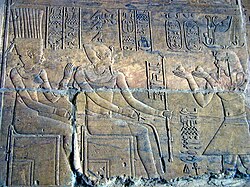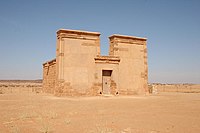| Arqamani | |||||||||||||||||||||||||||||||||||||||||||||
|---|---|---|---|---|---|---|---|---|---|---|---|---|---|---|---|---|---|---|---|---|---|---|---|---|---|---|---|---|---|---|---|---|---|---|---|---|---|---|---|---|---|---|---|---|---|
 Arqamani (right) presenting an offering, from the Temple of Dakka Arqamani (right) presenting an offering, from the Temple of Dakka | |||||||||||||||||||||||||||||||||||||||||||||
| Pharaoh | |||||||||||||||||||||||||||||||||||||||||||||
| Kushite king of Meroë | |||||||||||||||||||||||||||||||||||||||||||||
| Reign | late 3rd to early 2nd Century BCE | ||||||||||||||||||||||||||||||||||||||||||||
| Predecessor | Arnekhamani | ||||||||||||||||||||||||||||||||||||||||||||
| Successor | Adikhalamani | ||||||||||||||||||||||||||||||||||||||||||||
Royal titulary
| |||||||||||||||||||||||||||||||||||||||||||||
| Burial | Pyramid at Meroë: Beg. N 7 | ||||||||||||||||||||||||||||||||||||||||||||
Arqamani (also Arkamani or Ergamenes II) was a Kushite King of Meroë dating from the late 3rd to early 2nd century BCE.
Biography
It is believed that Arqamani ruled in Meroë at the time of the Egyptian revolt of Horwennefer against Ptolemy IV Philopator (reign 221–204 BC). He is attested by a number of inscriptions and reliefs from Kalabsha, Philae and the temple of Dakka. In the latter locality, he usurped some donation inscriptions originally inscribed for Ptolemy IV. He was buried in a pyramid in Meroë now known as Beg. N 7.
Arqamani took an elaborate ancient Egyptian royal titulary (see infobox) which likely reflects his control above the reconquered Lower Nubia and its inhabitants. He also took mortuary names: the mortuary Horus name is Kashy-netjery-kheper, meaning "The Kushite whose coming into being is divine", while his nomen is accompanied by the epithet Ankhdjet-meriaset, meaning "Given life, beloved of Isis", as well as Mkltk Istrk which is written in Meroitic script and whose meaning is not known.
He was sometimes tentatively identified with the king Ergamenes mentioned by Diodorus Siculus but modern scholars now believe that an earlier king with a similar name, Arakamani, is a better candidate for this identification. Nevertheless, Arqamani is sometimes called Ergamenes II.
-
 Temple of Apedemak in Musawwarat es-sufra, built by Arnekhamani
Temple of Apedemak in Musawwarat es-sufra, built by Arnekhamani
-
 Prince Arka, son of Arnekhamani, and possibly identical with Arqamani.
Prince Arka, son of Arnekhamani, and possibly identical with Arqamani.
-
 Pyramid of King Arqamani, Meroe Northern Cemetery
Pyramid of King Arqamani, Meroe Northern Cemetery
See also
References
- ^ von Beckerath, Jürgen (1999). Handbuch der Ägyptischen Königsnamen (in German). Mainz am Rhein, Von Zabern. ISBN 3-8053-2591-6. pp. 276-77.
- ^ Török (2008), p. 393.
- Clark, J. Desmond (1975). The Cambridge history of Africa. Cambridge University Press. pp. 228, 241. ISBN 978-0-521-21592-3. Retrieved 17 March 2011.
- Török (2008), p. 388.
- ^ Török, László, The Kingdom of Kush: Handbook of the Napatan-Meroitic Civilization, (1997).
- Török (2008), pp. 389–90 and references therein.
- Török, László (1996). Fontes Historiae Nubiorum, II. Bergen. ISBN 8291626014., p. 582.
Further reading and Bibliography
- Török, László (1996). Fontes Historiae Nubiorum. Vol. II. Bergen. ISBN 8291626014., pp. 660–662
- Török, László (2008). Between Two Worlds: The Frontier Region Between Ancient Nubia and Egypt 3700 BC - 500 AD. Brill. ISBN 978-90-04-17197-8.
